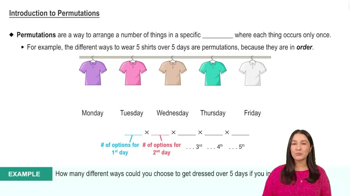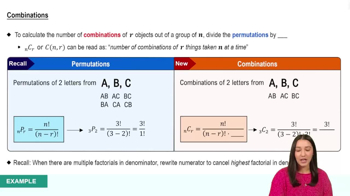Radio Station Call Letters Radio and Television station call letters must begin with either K (for stations west of the Mississippi River) or W (for stations east of the Mississippi River) and must include either two or three additional letters. How many different possibilities are there?
Table of contents
- 1. Intro to Stats and Collecting Data1h 14m
- 2. Describing Data with Tables and Graphs1h 55m
- 3. Describing Data Numerically2h 5m
- 4. Probability2h 16m
- 5. Binomial Distribution & Discrete Random Variables3h 6m
- 6. Normal Distribution and Continuous Random Variables2h 11m
- 7. Sampling Distributions & Confidence Intervals: Mean3h 23m
- Sampling Distribution of the Sample Mean and Central Limit Theorem19m
- Distribution of Sample Mean - Excel23m
- Introduction to Confidence Intervals15m
- Confidence Intervals for Population Mean1h 18m
- Determining the Minimum Sample Size Required12m
- Finding Probabilities and T Critical Values - Excel28m
- Confidence Intervals for Population Means - Excel25m
- 8. Sampling Distributions & Confidence Intervals: Proportion1h 12m
- 9. Hypothesis Testing for One Sample3h 29m
- 10. Hypothesis Testing for Two Samples4h 50m
- Two Proportions1h 13m
- Two Proportions Hypothesis Test - Excel28m
- Two Means - Unknown, Unequal Variance1h 3m
- Two Means - Unknown Variances Hypothesis Test - Excel12m
- Two Means - Unknown, Equal Variance15m
- Two Means - Unknown, Equal Variances Hypothesis Test - Excel9m
- Two Means - Known Variance12m
- Two Means - Sigma Known Hypothesis Test - Excel21m
- Two Means - Matched Pairs (Dependent Samples)42m
- Matched Pairs Hypothesis Test - Excel12m
- 11. Correlation1h 6m
- 12. Regression1h 50m
- 13. Chi-Square Tests & Goodness of Fit1h 57m
- 14. ANOVA1h 57m
4. Probability
Counting
Problem 4.4.23a
Textbook Question
Corporate Officers and Committees The Self Driving Unicycle Company was recently successfully funded via Kickstarter and must now appoint a president, chief executive officer (CEO), chief operating officer (COO), and chief financial officer (CFO), and chief human resources officer (CHR). It must also appoint a strategic planning committee with five different members. There are 15 qualified candidates, and officers can also serve on the committee.
a. How many different ways can the five officers be appointed?
 Verified step by step guidance
Verified step by step guidance1
Step 1: Recognize that the problem involves arranging 5 officers (president, CEO, COO, CFO, and CHR) from a pool of 15 candidates. Since the roles are distinct, the order in which the officers are chosen matters. This is a permutation problem.
Step 2: Use the formula for permutations, which is given by: , where 'n' is the total number of candidates (15) and 'r' is the number of positions to fill (5).
Step 3: Substitute the values into the formula: . This simplifies the calculation by canceling out the factorial terms from 10! downward.
Step 4: Expand the numerator (15!) up to the first 5 terms, as the rest will cancel with the denominator (10!): . This gives the total number of ways to arrange the 5 officers.
Step 5: Conclude that the result of this calculation represents the total number of distinct ways to appoint the 5 officers from the 15 candidates.
 Verified video answer for a similar problem:
Verified video answer for a similar problem:This video solution was recommended by our tutors as helpful for the problem above
Video duration:
2mPlay a video:
Was this helpful?
Key Concepts
Here are the essential concepts you must grasp in order to answer the question correctly.
Permutations
Permutations refer to the different arrangements of a set of items where the order matters. In this context, the appointment of corporate officers is a permutation problem because each position (president, CEO, COO, CFO, CHR) is distinct and the order of selection affects the outcome. The formula for permutations is n! / (n - r)!, where n is the total number of candidates and r is the number of positions to fill.
Recommended video:

Introduction to Permutations
Combinations
Combinations are selections of items where the order does not matter. In the context of forming a strategic planning committee from the pool of candidates, combinations are used because the arrangement of committee members is irrelevant. The formula for combinations is n! / [r!(n - r)!], where n is the total number of candidates and r is the number of members to choose.
Recommended video:

Combinations
Factorial
A factorial, denoted as n!, is the product of all positive integers up to n. Factorials are essential in calculating permutations and combinations, as they provide the total number of ways to arrange or select items. For example, 5! equals 120, representing the number of ways to arrange five distinct officers. Understanding factorials is crucial for solving problems involving arrangements and selections.
Recommended video:

Combinations

 7:11m
7:11mWatch next
Master Introduction to Permutations with a bite sized video explanation from Patrick
Start learningRelated Videos
Related Practice
Textbook Question
